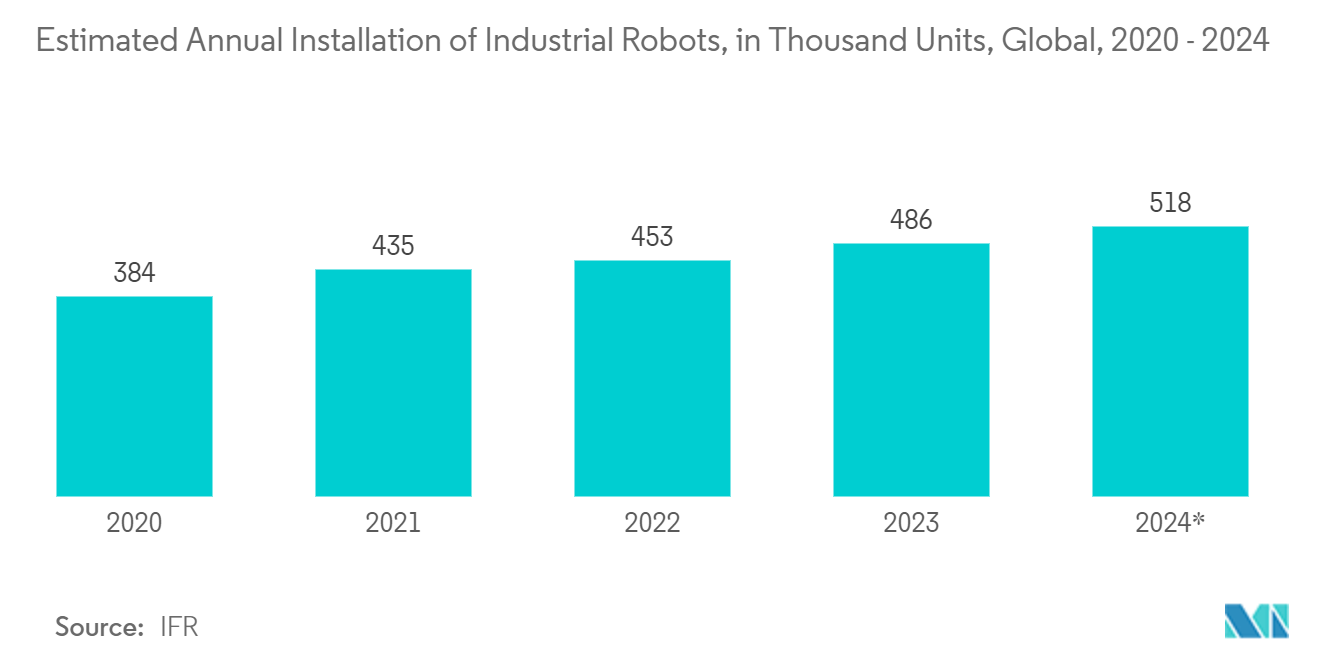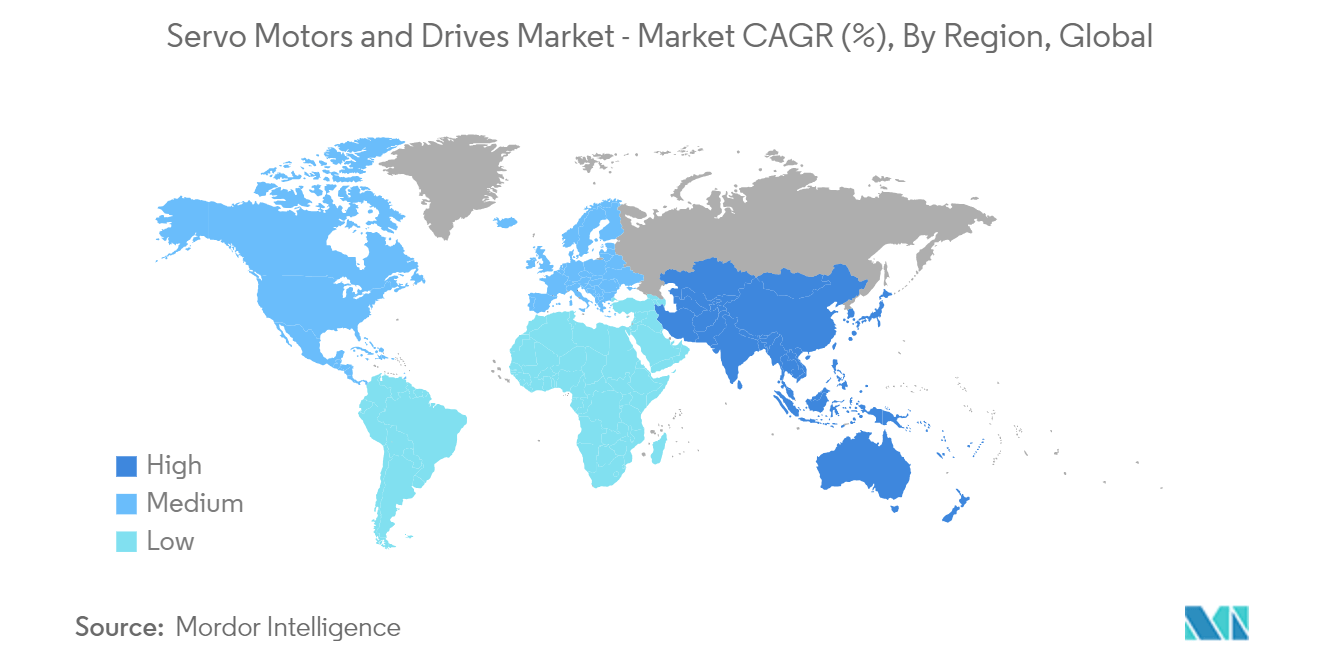Market Trends of Servo Motors And Drives Industry
Automotive Sector Is Expected to Hold Significant Market Share
- Servo motors play a crucial role in various automotive applications, contributing to the functionality and performance of different vehicle systems. Here are some common uses of servo motors in the automotive industry: Power Steering, Throttle Control, Brake Systems, Transmission and Gear Shift, HVAC Systems, and Headlight Control.
- There is an increasing use of servo motors and drives in the automotive industry and an increasing adoption of automation and robotics. Indeed, servo motors and drives play a crucial role in various automotive systems, including anti-lock brakes, fuel injection, cruise control, and more. They enable precise control and efficient operation of these systems, enhancing overall vehicle performance and safety.
- Robots have become integral in automotive assembly lines, performing tasks such as material handling, chassis assembly, painting, and more. This automation technology improves productivity, reduces errors, and lowers operating expenses for automakers. Collaborative robots, or "co-bots," are being utilized by major automotive manufacturers like Ford, Mercedes-Benz, GM, and BMW, further driving the demand for servo motors and drives.
- The automotive industry's increasing adoption of automation, digitalization, and artificial intelligence (AI) is propelling the demand for industrial robots. Automation improves manufacturing processes, enhances efficiency, and enables flexibility in production lines. As per the report you mentioned, experts predict that up to 75% of vehicles will be produced by robots by 2025, indicating the significant role of robotics in the automotive industry.
- With the growth in automation and robotics, the automotive industry's market for servo motors and drives is expected to expand. According to IFR, global industrial robot shipments amounted to approximately 3,84,000 in 2020. It is forecasted that 2024, the global industrial robot shipments will be about 518,000. Organizations recognize the benefits of automating their facilities to improve productivity and efficiency. This trend, coupled with the integration of digitalization and AI, contributes to the increasing demand for servo motors and drives in the automotive sector.
- Overall, the automotive industry's push toward automation and robotics is driving the demand for servo motors and drives. These components enable precise control, enhance productivity, and support adopting advanced manufacturing processes in the automotive sector.

Asia Pacific Expected to Witness Significant Growth
- The market for servo motors and drives in Asia-Pacific is expanding significantly due to the rising number of industries in the region and their integration with automation to increase ROI. The Asia-Pacific servo motors and drives market is predicted to be dominated by China with the growing production, sales, and trade of robotic solutions in China.
- The Chinese market for servo motors and drives is growing rapidly in the EMEA and Americas regions as the country continues to focus on industrial automation. For instance, the Ministry of Industry and Information Technology (MIIT) in Beijing released the "14th Five-Year Plan" for Robot Industry Development on 21st December 2021, focusing on promoting innovation to make China a global leader in robot technology and industrial advancement by including it in 8 critical industries for the next five years. As per the recent 2023 World Robot Conference, China's robotics industry has achieved significant progress, with revenue exceeding CNY 170 billion (USD 23.3 billion) in 2022, with China's sales of industrial robots accounting for more than 50% of the world's total in 2022, ranking first globally for ten consecutive years.
- Japan is rapidly moving toward the concept of "Society 5.0," introducing the fifth chapter to the four major stages of human development. In this new ultra-smart society, all things are connected through IoT technology, and all technologies are integrated, dramatically improving the quality of life. To realize this new era, the Government of Japan is taking various suitable steps to encourage various players, including start-ups and "hidden gems" among small- and medium-sized enterprises, to come up with brand-new and innovative ideas for facilitating the world with solutions to problems such as labor shortages owing to population. In a country such as Japan, known for bringing large-scale industrial robots to the factory floor, these problems in the manufacturing sector have led such relatively dainty machines to be dismissed as niche and low-margin. These factors are likely to drive the growth of the servo motors and drive market in the country as servo controllers are taking robotic automation to the next level by making it possible for machines to make smooth, repeatable, and exact movements. Together, those characteristics allow electronic design engineers to create fascinating innovations.
- The action plan for manufacturing and service included projects such as advanced air mobility, autonomous driving, or the development of integrated technologies as the core of next-generation artificial intelligence and robots. Additionally, a budget of 440 million USD was allotted to robotics-related projects in the "Moonshot Research and Development Program" for five years from 2020 to 2025.
- The Indian automobile industry has historically been a significant indicator of how well the economy is doing, as the automobile sector plays a crucial role in both macroeconomic expansion and technological advancement. According to the Organisation Internationale des Constructeurs d'Automobiles, a record 4.7 million passenger cars and commercial vehicles were sold in India in 2022. In addition, the electric vehicle (EV) market is estimated to reach USD 7.09 billion in India by 2025. A study by the CEEW Centre for Energy Finance recognized a USD 206 billion opportunity for electric vehicles in India by 2030. This is expected to necessitate a USD 180 billion investment in vehicle manufacturing and charging infrastructure.


